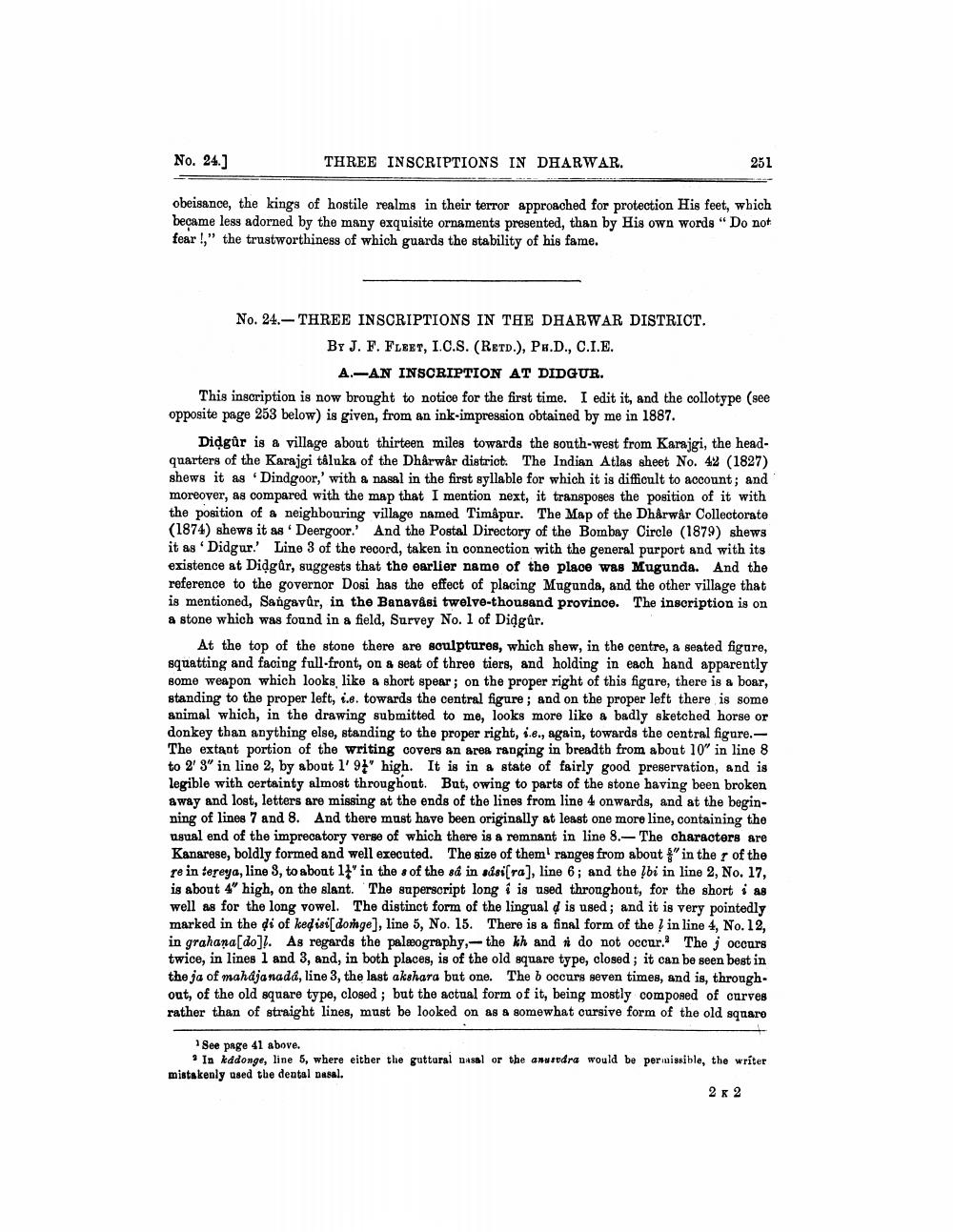________________
No. 24.]
THREE INSCRIPTIONS IN DHARWAR.
251
obeisance, the kings of hostile realms in their terror approached for protection His feet, which became less adorned by the many exquisite ornaments presented, than by His own words "Do not fear!," the trustworthiness of which guards the stability of his fame.
No. 24.-THREE INSCRIPTIONS IN THE DHARWAR DISTRICT.
BY J. F. FLEET, I.C.S. (RED.), Pe.D., C.I.E.
A.-AN INSCRIPTION AT DIDGUR. This inscription is now brought to notice for the first time. I edit it, and the collotype (see opposite page 253 below) is given, from an ink-impression obtained by me in 1887.
Didgûr is a village about thirteen miles towards the south-west from Karajgi, the headquarters of the Karajgi taluka of the Dhårwår district. The Indian Atlas sheet No. 42 (1827) shews it as Dindgoor,' with a nasal in the first syllable for which it is difficult to account; and moreover, as compared with the map that I mention next, it transposes the position of it with the position of a neighbouring village named Timåpur. The Map of the Dharwar Collectorate (1874) shews it as Deergoor.' And the Postal Directory of the Bombay Circle (1879) shews it as Didgur.' Line 3 of the record, taken in connection with the general purport and with its existence at Didgar, suggests that the earlier name of the place was Mugunda. And the reference to the governor Dosi has the effect of placing Mugunda, and the other village that is mentioned, Sangayûr, in the Banavisi twelve-thousand province. The inscription is on a stone which was found in a field, Survey No. 1 of Didgør.
At the top of the stone there are sculptures, which shew, in the centre, a seated figure, squatting and facing full-front, on & seat of three tiers, and holding in each hand apparently some weapon which looks like a short spear; on the proper right of this figure, there is a boar, standing to the proper left, i.e. towards the central figure; and on the proper left there is some animal which, in the drawing submitted to me, looks more like a badly sketched horse or donkey than anything else, standing to the proper right, i.e., again, towards the central figure.The extant portion of the writing covers an area ranging in breadth from about 10" in line 8 to 2' 3" in line 2, by about 1' 91' high. It is in a state of fairly good preservation, and is legible with certainty almost throughout. But, owing to parts of the stone having been broken away and lost, letters are missing at the ends of the lines from line 4 onwards, and at the beginning of lines 7 and 8. And there must have been originally at least one more line, containing the ngual end of the imprecatory verge of which there is a remnant in line 8.- The characters are Kanarese, boldly formed and well executed. The size of them! ranges from about " in the r of the re in tereya, line 3, to about 1' in the sof the sá in adsi[ra], line 6; and the (bi in line 2, No. 17, is about 4' high, on the slant. The superscript long i is used throughout, for the short i as well as for the long vowel. The distinct form of the lingual d is used; and it is very pointedly marked in the di of kedisi[ donge], line 5, No. 15. There is a final form of the I in line 4, No. 12, in grahana[do]. As regards the palæography, -the kh and do not occur. The occurs twice, in lines 1 and 3, and, in both places, is of the old square type, closed; it can be seen best in the ja of mahajanada, line 3, the last akshara but one. The b occurs seven times, and is, throughout, of the old square type, closed; but the actual form of it, being mostly composed of curves rather than of straight lines, must be looked on as a somewhat cursive form of the old square
See page 41 above.
In kadonge, line 5, where either the guttural nasal or the ansodra would be permissible, the writer mistakenly used the dental nasal.
2 x 2




